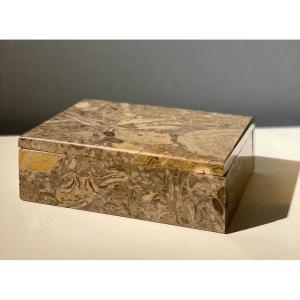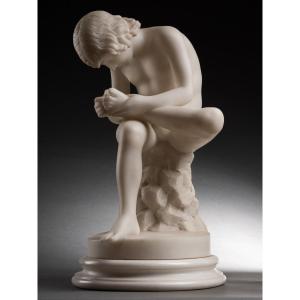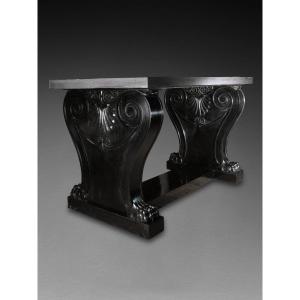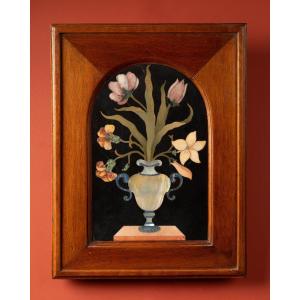19th century.
Italy.
h. 63 cm ; w. 32 cm.
Marble bust of the Venus italica after one of the four versions of the Venere italica, sculpted by Antonio Canova between 1804 and 1822.
Antonio Canova had designed the Venere italica as part of an Italian movement to replace the Uffizi's Medici Venus, after it had been displaced to Palermo in order to escape looting by Napoleonic troops. The statue was then handed, after diplomatic pressure from Talleyrand, and sent to Paris to be held in the ‘Musée Napoléon’, that is to say the Louvre, where it was indeed exhibited as soon as 1803.
Bonaparte expressed his interest in the Medici Venus in the early days of the ‘campagnes d’Italie’ : to the French Directoire, in July 1796, he wrote : ‘I have seen in Florence the famous Venus which is missing from our Museum...’.
Since that visit, Tommaso Puccini, director of the Uffizi, who had toured Bonaparte himself in the museum, knew what threats loomed over the statue. He had the Medici Venus sent to Palermo in 1800, along with other important pieces from the Uffizi collections, so they could escape the looting of Republican troops. Yet, Tommaso Puccini was well aware that the Venus, despite being sent away in Sicily, remained in danger, as even the Apollo Belvedere ended up in Paris. Puccini seemed to feel that only a modern copy of the Venus by the greatest sculptor alive could make up for this loss. In 1802, accordingly, as Canova was visiting Florence, Puccini asked him to sculpt a copy of the Medici Venus, not as such as the statue was known at the time, after many modern restorations that had often been criticised in the 18th century, but as Canova could imagine the statue had originally been ; or as if, at least, these restorations had been corrected by Canova.
Canova, at first reluctant, agreed ; then he decided not only to produce an ideal copy of the Medici Venus for the Uffizi, but to add a ‘twin’ Venus of his own invention. Canova's desire to produce a copy of the antique gradually gave way to that of sculpting a new Venus. And perhais this was also due to the difficulty of producing a Venus that would satisfy both amateurs accustomed to the restorations of the Medici Venus, and the erudites who had come aware of the inadequate restorations that the statue had suffered. Four versions were thus sculpted by Canova after the modello of his new Venus : the Venere di Monaco, that is to say from Munich, still kept at the Residenz and completed for Ludwig I of Bavaria in 1810 ; the Venere italica, completed in 1811, installed for a time at the Uffizi Gallery before the return of the Medici Venus in 1815, and now at the Palazzo Pitti ; a Venus commissioned by Lucien Bonaparte, Napoleon's brother, sculpted between 1811 and 1814 and now lost ; and one Venus at last, known as the Hope Venus, completed for Thomas Hope in 1820 and kept since 1959, after various sales, donations and inheritances, at the City Art Gallery in Leeds.
It should be noted that there is a strong resemblance between the famous marble of Pauline Borghese as Venus vitrix and the face of the Venus italica : although it is almost certain that Pauline Borghese herself actually posed for the body before Canova, it is likely that her face was influenced by the modello designed by Canova for the various versions of the Venus italica.
Subtle details in the modelling of the face and hair, in particular the number of curls above the forehead, indicate that this marble bust was sculpted after the Venus in the Palazzo Pitti and not the one in the Residenz, nor the Hope Venus, or even the bust in the Hermitage that was attributed to Canova at the end of the 20th century. Some damage to the marble.
Sources
Correspondance de Napoléon Ier publiée par ordre de l'Empereur Napoléon III, t. I, Paris, 1858.
Éouard Driault, Napoléon en Italie (1800-1812), Paris, 1906.
Nina Kosareva, Canova and his Works in the Hermitage, St Petersburg, 1961.
Hugh Honour, ‘Canova's Statues of Venus’, in The Burlington Magazine, vol. 114, no. 835, October 1972.
Mario Praz and Giuseppe Pavanello, L'Opera completa del Canova, Milan, 1976.
Francis Haskell and Nicholas Penny, Taste of the Antique. The Lure of Classical Sculpture. 1500-1900, New Haven, 1981.
Antoinette Le Normand-Romain, ‘Le Néo-classicisme’, in La Sculpture, de l'antiquité au XXe siècle, Geneva, 2015.


































 Le Magazine de PROANTIC
Le Magazine de PROANTIC TRÉSORS Magazine
TRÉSORS Magazine Rivista Artiquariato
Rivista Artiquariato